PDF chapter test TRY NOW
Ramachandra Guha, being a cricket Historian, traces the origin of the game and explains its uniqueness in the lesson. He notes that cricket can be traced back to the early games that were played in England around \(500\) years ago. This can be attributed to the fact that the British had colonised nearly half the continent in the early \(1800s\). The British had entered India right after the Dutch and Portuguese initially to trade spices and other valuables. The East India Company, which was formed to trade, was handed over to the crown. Slowly they started taking control and India was fully colonised by the end of \(1853\). The British culture, interests, etiquettes were deeply forced on the Indian people. Cricket, which was by then a famous sport in England, was introduced to Indians. Indians started establishing teams and played amongst each other.

Oldest cricket bat*
Cricket in England was brought in by early Dutch and French settlers around \(500\) years ago. It was initially played with sticks and very little equipment. It was initially played by young boys from lower strata and exiles. Since it was played with sticks and clubs, instead of the bat that is being used now, the word 'Bat' is derived from the 'Batte', which is old English for stick or 'Battre', which means to strike. For a long time, till the eighteenth century, the cricket bat looked almost similar to a hockey stick, as it had a curve towards the end. Like hockey, the ball was not thrown in the air; instead, it was rolled over in the ground. In today's cricket, the bowler pitches a ball to the batsman, which he hits with the bat.
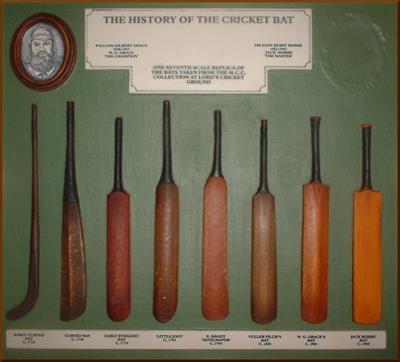
Evolution of the cricket bat**

Cricket in a non-formal scenario
A Test match is where two teams with \(11\) players each play for around \(5\) days. Usually, there are \(4\) innings. An inning is a turn taken by each team to bowl and bat. So each team bats twice and bowls twice in the five days. But the most tiring part is that even after playing for \(5\) days, each team can score the same and it can end in a draw. Nearly all the other sports take only half the time that a test cricket takes. Football consists of two halves with 45 minutes each which equals to 90 minutes. Baseball is considered to be a shortened version of cricket, but still, its duration amounts to half the time taken by cricket.
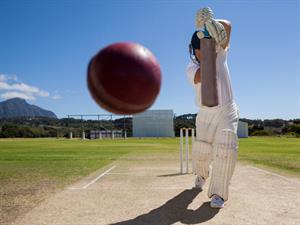
Ball pitched in the air
Cricket is a game that is played between two teams with eleven players. Each team takes turn in batting and bowling. Usually, the first team to bowl aligns all their players in different parts of the ground and has one bowler who delivers the ball. The batsmen are placed at two corners of a rectangular area called 'Pitch'. The pitch is usually \(22\) yards, and after hitting the ball, the batsman runs from one end to the other end of the pitch to score runs. But the size of the ground that the game is played is not fixed, unlike the size of the pitch, which remains unchanged. Sometimes the ground can be circular in shape like the one in Chepauk Stadium, Chennai. It can sometimes be oval, like the Adelaide Oval, which is a famous stadium in Australia. It even gained its name from the shape of the ground.
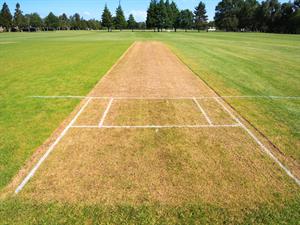
A cricket pitch
A six is when the batsman hits the ball into the gallery or beyond the boundaries without touching the ground. But the size of the stadium can also sometimes determines the hitting of sixers. In an oval ground, the ball has to travel a little more than in a circular one. Guha gives the example of how the Melbourne stadium in Australia has an oval ground and compared to Feroz Shah Kotla Stadium in Delhi. A ball has to travel more distance in the air for a player to hit a six.
Guha also explains the historical reason as to why the size of the ground is not standard, unlike all other sports like hockey or football, which have specific dimensions for their grounds. He explains how cricket as a game evolved to a great deal from time immemorial. Although cricket was played from a very early time, it was soon codified, meaning that it was regulated and certain laws were established. The first ever regulated law of cricket was established in \(1744\). One of the decisions made was the appointing of umpires in the game. When a game is played, there are two teams and it is always subjected to some sort of dispute. If the team members get to decide, then there is a high chance they are biased. So the umpires, who have no connection to the teams, were appointed to settle disputes in a fair and unbiased manner. The umpires were selected among the members of the governing bodies. The batsman gets out once the ball hits the three stumps or wickets behind him. It was decided that the stumps should be \(22\) inches. There are smaller sticks placed on top of the wicket called bails which is six inches. Also, the ball must be between five or six ounces.
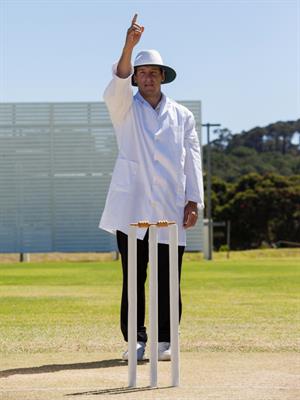
An Umpire behind the stumps
The codified laws were set up by some of the founding clubs and organisations. The first cricket club was founded in Hambledon in the \(1760s\). A cricket club forms and enrols teams from all localities and conducts and gets sponsors for matches. It formed and conducted its first match between Essex and Middlesex, in the grounds sponsored by Thomas Lord, which later went on to become the famous Lord's stadium. The ground was in a place called Marylebone, which was the base for the MCC (Marylebone Cricket Club) in \(1787\). This club was laid out the rules for appointing umpires, dimensions of the ground etc.
One of the most defining changes was the replacement of rolling the ball by the bowler to spinning it towards the batsman. This gave them a lot of space to experiment, as they got to choose the speed with which they can spin a ball, the speed and length they need to pitch the ball. On the other hand, the batsmen have to study the types of shots to hit balls of varying speed and length. When the ball was rolled over, they had enough time to strike, but when it is swung, the timing has to be concentrated as well. As a result of this change, the stick/bat was changed into a long one without the curve in the end. The ball's weight was decided to be \(5\) \(1/2\) or \(5\) \(3/4\) ounces. The width of the bat was four inches, as it was easy to hit the ball. In cricket, if the ball hits the wicket, then the batsman gets out.
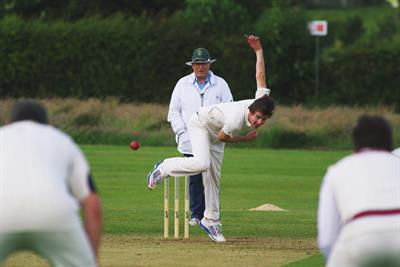
Bowling in the air
Initially, batsmen used to block the ball from hitting the wicket with their leg. To avoid this the leg before wicket rule was established in \(1774\). By the rule, if the ball had the chance of hitting the wicket, and the batsman's leg comes in between as a means to stop it, then he was given an out. Around this time, there was another rule regarding the stumps, when there were only two stumps until then. In \(1775\), in a particular match, an English bowler named Lumpy Stevens, who was considered the greatest bowler of the time, bowled three consecutive balls to his batsman, which passed through the two stumps. It was then changed to three stumps. The longest duration of a match that was played changed to as long as three days. A cricket ball was usually made with twines wound together around a red shell. It is brought together by a seam that stitches them. The first six seam cricket ball was made around this time, which means that the circular stitching that joins the two halves of the ball had around six rows of stitches, which gives it a unique gripping and ability to swing.
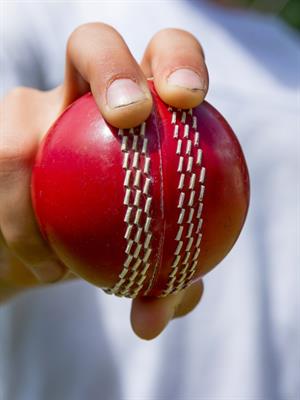
A six seamed cricket ball
Guha gives another example of how cricket has evolved through the years. He talks about the equipment used by the cricketers and how it has undergone certain changes. Although there have been many changes as the years went by, it stayed true to the spirit of the game. Cricket originated in England, and even today, it still has not altered the essence of the game from the times it began. In the beginning stages, it was played only for the sake of entertainment among young boys. But even then, the equipment and the method of the game was the same as the present times. There were alterations only in the shape and the size. The materials with which it was made were natural and pre-industrial ones.
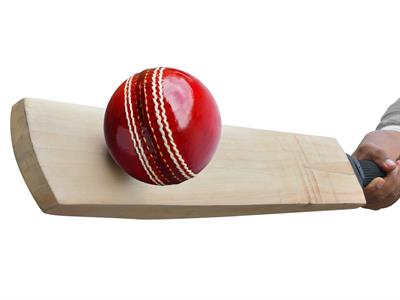
Bat and ball from pre industrial materials
Pre-industrial materials refer to those that were used or manufactured before the industrial revolution. Cricket was existent even before the \(19th\) century, when the Industrial Revolution began. Initially, people played with sticks, stumps, twine balls etc, which remains the same even today. There were no factories or machines that produced the equipment in bulk quantities. Most localities had a shop where a craftsman who had expertise in the area would make handmade bats and balls from trees and other small wooden things.
A cricket bat is made of stuff like leather, twine and cork. But as time progressed, the material of the bat changed as it had to be more flexible to overcome a ball that is pitched in the air. So the cricket bat is now made out of the wood of a willow tree. Initially, the bat was made out of a single piece of wood cut from the same tree. But as years progressed, the handle was made out of cane, which is the hollow jointed stem of tall grass like bamboo or sugarcane. The hollow cane is moulded to make the handle of the bat to provide more grip. The rest of the batting portion is made out of the wood of a willow tree. The production of cane became significant in the colonising agenda of European traders, as millions of African slaves were brought and made to toil in sugarcane plantations, thereby earning profit. Other games like golf and tennis have made use of man made materials like fibreglass or plastic, which is a trend that cricket has refused to adhere to. But when it comes to the parts of the equipment like pads, guards, helmets etc, cricket has made good use of technological advancements as they are required to be safe. The pads and gloves that were introduced in \(1848\) are made up of vulcanised rubber, and the helmets are made up of metals and other lightweight synthetic materials.
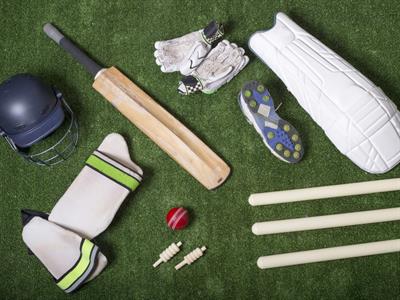
Cricket equipment
In India, the East India Company and the British colonisers brought in their game of cricket and the locals were highly influenced by the new game. Until then, India had their own native games like Kabaddi, Ghilli Danda, Kho Kho etc. But the advent of cricket in the main city of Bombay reversed people's take towards games. But Indians were initially sceptical towards the game as it was considered to be the white man's tool to subjugate them. But the first Indian communities to extend their support and partake in cricket where the community who followed Zoroastrianism, the Parsis. The Parsis were immigrants from the modern day Iran, when there was a Muslim conquest in Persia around the \(7th\) century BC. Since they were not natives of India, they easily entered into trade and business with the British. They traded textiles, steel, leather etc. As a result of these trades, they were more westernised in their approach and accepted the white man's game.
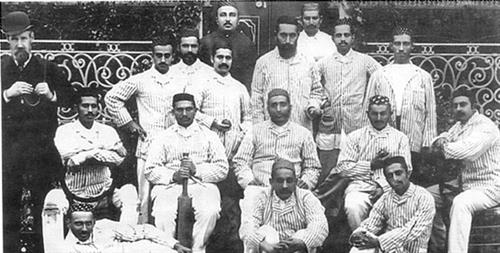
The Parsi team that toured England in 1886***
The Parsis found the first cricket club in India called the 'The Oriental Cricket Club' in Bombay in \(1848\). The word Orient means the influence of the West. These clubs helped to establish the games within the country and were sponsored by great Parsi businessmen like the Tatas and Wadias. Although the Parsis embraced their game, the English officials were not ready to offer any support for them. They had their own club in India and did not want the natives to take over them. They had a famous club called the 'Bombay Gymkhana club', which was exclusively only for males. A gymkhana was nothing but a sports club, with which the Parsis had an ongoing debate. The sport arena was used by the white people to train their ponies which were used in the game of Polo. The ponies dug up the ground with their hooves which made it unsuitable for playing cricket.
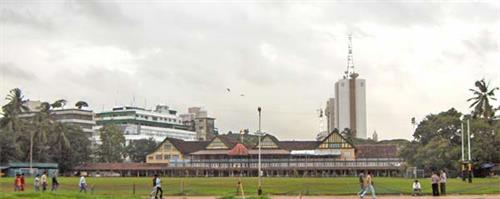
The Bombay Gymkhana****
The officials of the gymkhana were biased towards the British, which made the Parsis to build their own gymkhana for playing the game. This rivalry ended up in favour of the Parsis, as they won a swooping victory in a match conducted between the teams of Bombay Gymkhana and the new team in \(1889\). This was four years after the formation of the Indian National Congress in \(1885\). Dadabhai Naoroji, who was one of the earliest leaders of the congress, was a Parsi, which gave more strength and support for them.
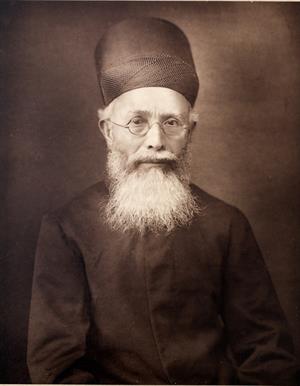
Dadabhai Naoroji*****
In today's world, test matches and one-day Internationals are the ones that fans are eager to follow. Every country has a national cricket team, which represents the Nation. Every International match and test cricket is played between the National teams. Getting into a National team is not easy, as the players have to go through a various selection process, play for their local teams, get selected, perform well in the Ranji trophy etc. These cricketers who perform really well gain popularity amongst the crowd, as they gain a reputation for the entire Nation. Cricket is not only seen as a form of entertainment or a mere sport, it is an emotion and people connect to it personally. They see each victory as their own personal victory. They see the cricketers as their own family. Most of the famous cricketers who stay on the mind of the audience even after retirement are mostly the ones that have made phenomenal results in test matches.

People celebrating cricket
Guha gives the example of one such test player who is still fondly remembered by Indian cricket fans. C. K Naydu, who was an outstanding batsman of his time, still remains in the hearts of the audience. He was prominent in the \(1950s\) and produced several records for the Nation. He played for India in its first Test matches against England starting in \(1932\). His contemporaries such as Palwankar Vithal and Palwankar Baloo, were really famous when they played the game but soon faded out of the audience's memories as they did not have enough records in test matches and were not very consistent. Naydu is still remembered because he was the country’s first Test captain.
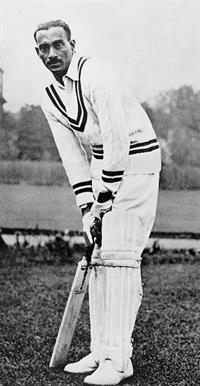
CK Naydu******
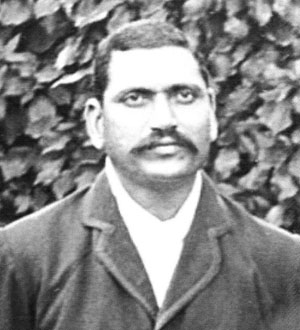
Palwankar Baloo*******
India played its first Test match in \(1932\). This was around \(13\) years before India gained independence from the British in \(1945\) and was established as a separate country. The first test cricket match had its origin in \(1877\), where it was played among the British colonies and not between the Nations. The British had colonised nearly all countries and the first test match of India was played with Australia, which was another British colony. Many colonies like West Indies, which was a group of islands from the Caribbean until the second World war also took part in the game, and is now one of the best teams that exist.
Guha explains that cricket became more famous after the advent of technology. Even if the game had not adapted technology in manufacturing the equipment, it has definitely helped as a tool of propagation. Initially, when a was fixed and played in some part of the Nation, the score would be broadcasted via radio. Every small town or village used to have one transistor or radio set in one particular locality, such as a tea shop or a sport's club. People gathered at one place and listened to the score and who was on the winning side. But with the advent of television, people cherished the idea of watching the match that was happening in a distant land, from the comfort of their own home. This broadened the fan base for cricket. Young children got really impressed and the game shaped them from a very young age, as they got to see their favourite idols and imitate them. Many dreamed of becoming cricketers someday.

Watching cricket on a television
The technological advancements in satellite television increased the global market of cricket. People from all over the world started watching and following the game. Matches were telecasted live, which gave them the feel of watching it from the stadium. A match in Sydney could be viewed from a small village in Surat. India has the second highest population and also had the highest viewership of cricket and the largest market in the cricketing world. This made the game's focus shift to South Asia, even larger than the home ground of cricket, England. The ICC headquarters was moved from London to Dubai as it is a tax free Nation. Guha recalls how one hundred and fifty years ago, the Parsis had to struggle to get a proper gymkhana for training and had to wait so long for their first victory due to white prejudices. Today, Indian cricket has been raised to a higher pedestal and has gained a great reputation in the eyes of fans across the globe. Cricketers like Virat Kohli, M.S Dhoni have world wide recognition and a good rapport with all international cricketers. The IPL is conducted every year in India, which brings in the best of international players and is followed by fans all over the world. Guha attributes this success to smaller changes such as replacing a very sluggish casual way of playing sports to making it paid and professional. The one-day matches have dominated the Test matches and became more popular as days went by, and the technological advancements also contributed to it.
Reference:
Oldest cricket bat*: Rodrigo, CC BY-SA 3.0, Wikimedia
Evolution of the cricket bat**: Bodnotbod, BY-SA 3.0, Wikimedia
The Parsi team***: Rustom Deboo, Specials - Parsis Pioneers Of Cricket In India, Part 1, The Cricket Cauldron
The Bombay Gymkhana****: Nichalp, CC BY-SA 2.5
Dadabhai Naoroji*****: See page for author, Public domain, via Wikimedia Commons
CK Nayudu******: Unknown author, Public domain, via Wikimedia Commons
